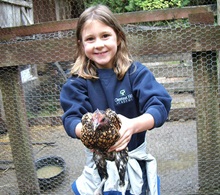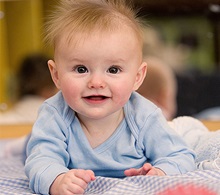 You’ve probably heard about the benefits of nature and outdoor play for children. According to the National Wildlife Federation, outdoor play boosts fitness and decreases the risk of childhood obesity; increases focus and academic achievement; and reduces stress and increases feelings of well-being.
You’ve probably heard about the benefits of nature and outdoor play for children. According to the National Wildlife Federation, outdoor play boosts fitness and decreases the risk of childhood obesity; increases focus and academic achievement; and reduces stress and increases feelings of well-being.
As a provider of quality childcare, we understand and agree with all these findings. While less tangible and quantifiable, the “fun” value of being outdoors can also be beneficial to children, particularly when they can share that fun with a beloved adult.
Conservationist Rachel Carson wrote, “If a child is to keep alive his inborn sense of wonder, he needs the companionship of at least one adult who can share it, rediscovering with him the joy, excitement, and mystery of the world we live in.” We think she’s onto something there. Below are a few simple outdoor activities for kids that we at Premier Academy think can help nurture a love of the natural world within your child.
Infants and Toddlers
Offer safe spaces for babies to crawl, walk, and explore, such as a variety of textured surfaces (e.g. grass, sand, or dirt). Point out and label birds, squirrels, insects and plants.
Toddlers are at a vantage point to observe things that we adults often miss. A simple walk around the neighborhood with the family can open a whole world to them if we simply slow down. We believe quality childcare starts with giving children the freedom to discover and explore! Make time to explore with toddlers, keeping in mind the journey, not the destination. How many plants and insects can you find? How many different textures or sensations can you discover?
Preschoolers
Offer your child a variety of natural and re-purposed materials, such as old metal pie tins, sticks, ribbon, wire, spoons, shells, or rocks. What can you make with these materials? How about wind chimes, a bird feeder, or an old-fashioned mud pie?
Speaking of old-fashioned fun, remember Winnie the Pooh and his game of “pooh sticks”? Gather several sticks of similar size and give each player a stick. On the count of three, drop the sticks from one side of a bridge. Run to the other side and watch for the sticks to float downstream. Which stick emerges first? Based on the natural world you see around you, improvise fun outdoor games for kids.
School-Agers
Get an up-close view of pond life. Cut the ends off a large cylindrical plastic container, such as a large food container or even a milk jug. Secure plastic wrap over one end with a rubber band or waterproof tape. Place the wrapped end of the container in a stream or pond. Look into the other end. The glare of the sun is diminished when looking through the container, so it’s easier to see plant and animal life in the water.
Grow something. School-age children are at an ideal age to learn about gardening. If you have the space, you can try easy-to-grow crops like lettuce, carrots, peas, and tomatoes in a full-size garden, a raised bed, or even pots. Try fast-growing flowers like pansies, nasturtiums, or sunflowers. How about a few herbs on the patio?
When asked why he felt optimistic that humans would find solutions to the environmental concerns plaguing our planet, physicist Freeman Dyson responded, “Because people will always love trees.” If children are removed from nature, though, will future generations develop this age-old wisdom? We believe at Premier Academy that experiencing nature with children through outdoor play has benefits today and for years to come as children become the stewards of our planet. So, get out there. Turn over a rock. Feel the breeze on your face. Get some dirt on your shoes.



 Returning to work after maternity leave is never easy. The prospect of being away from your new baby, the pressure of performing at work and lack of sleep are just a few of the obstacles you will face. However, there are ways to make the transition easier on you and your baby and it won’t be long until your entire family adjusts to its new normal.
Returning to work after maternity leave is never easy. The prospect of being away from your new baby, the pressure of performing at work and lack of sleep are just a few of the obstacles you will face. However, there are ways to make the transition easier on you and your baby and it won’t be long until your entire family adjusts to its new normal. We here at Premier Academy know that returning to work after maternity leave can be a difficult transition for mothers. The prospect of being away from your new baby coupled with the pressure of performing at work can lead to a great deal of stress. Throw sleep deprivation into the mix and it is easy to understand why this can be such a trying time for many women.
We here at Premier Academy know that returning to work after maternity leave can be a difficult transition for mothers. The prospect of being away from your new baby coupled with the pressure of performing at work can lead to a great deal of stress. Throw sleep deprivation into the mix and it is easy to understand why this can be such a trying time for many women. Are there benefits to teaching your child baby sign language? Although some studies point to increased intellectual development, the primary benefit of using baby sign language is decreased frustration for both you, your daycare provider, and your baby. Babies can use sign language to communicate their wants and needs long before they begin using words.
Are there benefits to teaching your child baby sign language? Although some studies point to increased intellectual development, the primary benefit of using baby sign language is decreased frustration for both you, your daycare provider, and your baby. Babies can use sign language to communicate their wants and needs long before they begin using words.  Some children are born social butterflies, intuitively understanding the art of making and keeping friends. Other children need a bit more support. Many children are naturally quiet or reserved and may not know how to start a conversation. Others need help in reading social cues, sharing toys, or taking conversational turns.
Some children are born social butterflies, intuitively understanding the art of making and keeping friends. Other children need a bit more support. Many children are naturally quiet or reserved and may not know how to start a conversation. Others need help in reading social cues, sharing toys, or taking conversational turns. You’ve probably heard about the benefits of nature and outdoor play for children. According to the National Wildlife Federation, outdoor play boosts fitness and decreases the risk of childhood obesity; increases focus and academic achievement; and reduces stress and increases feelings of well-being.
You’ve probably heard about the benefits of nature and outdoor play for children. According to the National Wildlife Federation, outdoor play boosts fitness and decreases the risk of childhood obesity; increases focus and academic achievement; and reduces stress and increases feelings of well-being. After a busy week of responsibilities, caring for children, and working in and out of the home, we cherish opportunities to be with family members. Shared quality time strengthens your family bond and helps everyone feel valued and respected. It is not necessary to make elaborate plans or partake in costly undertakings to enjoy family time.
After a busy week of responsibilities, caring for children, and working in and out of the home, we cherish opportunities to be with family members. Shared quality time strengthens your family bond and helps everyone feel valued and respected. It is not necessary to make elaborate plans or partake in costly undertakings to enjoy family time. Mentoring is one of the oldest teaching methods in the world. Mentoring is really a personal coaching strategy where someone that has a specific skill or subject matter expertise works with another person to impart their knowledge in a very personal and connected way.
Mentoring is one of the oldest teaching methods in the world. Mentoring is really a personal coaching strategy where someone that has a specific skill or subject matter expertise works with another person to impart their knowledge in a very personal and connected way. Bringing home a new baby is an exciting and magical event for any family. Preparing your home in advance for the big day helps parents to proactively provide built in safety for the new addition to the family.
Bringing home a new baby is an exciting and magical event for any family. Preparing your home in advance for the big day helps parents to proactively provide built in safety for the new addition to the family.